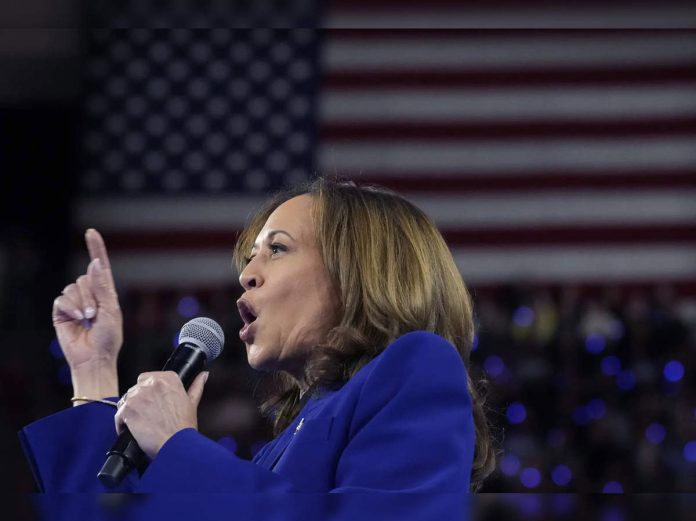By M A Hossain
As the US presidential election approaches, Kamala Harris stands on the brink of making history. With approximately 70 days left in a compressed campaign, Harris is poised not only to become the first woman to ascend to the presidency but also to be the first president of Black and South Asian descent. Despite the significance of these firsts, Harris has made it clear that her identity is not the focal point of her campaign. Instead, she has chosen to transcend these aspects, focusing on broader themes of unity, patriotism, and a shared American future.
At the recent Democratic National Convention, Harris’s acceptance speech was a masterclass in navigating the complexities of identity politics while appealing to a broad electorate. Notably, she refrained from directly addressing her race or gender, except in brief references to her Jamaican father and her mother, a “brilliant five-foot-tall woman with an accent.” This deliberate vagueness allows Harris to sidestep the potential pitfalls of being pigeonholed by her identity, positioning herself as a candidate for all Americans.
Harris’s campaign strategy appears to be built on the premise that this election is about more than just party lines or personal identity. It is about the future of the nation and the values that bind its people together. Her message is one of optimism, emphasizing the potential for positive change and the need to move beyond the bitterness and division that has characterized recent years. In her words, this election offers a “precious, fleeting opportunity to move past the bitterness, cynicism, and divisive battles of the past.”
Harris’s campaign faces significant challenges, particularly in winning over the approximately 10 percent of undecided and independent voters in a deeply polarized electorate. While the Democratic convention succeeded in introducing Harris to a broader audience and effectively reframing Donald Trump as a small yet dangerous threat, the task of convincing undecided voters remains daunting.
Harris’s speech at the convention was a careful balancing act. While she leaned toward centrist policies, avoiding extravagant promises on healthcare or the economy, some observers noted a conservative tilt, particularly in her support for a bipartisan border bill. This centrist approach is likely an attempt to appeal to a broader spectrum of voters, including those who may have been alienated by more progressive elements of the Democratic Party.
However, there is a recognition within the Democratic camp that Harris must do more than just present herself as a safer alternative to Trump. She must also address the widespread perception that Trump is better equipped to handle the economy, a key issue for many voters. While Trump has faced criticism for his handling of the COVID-19 pandemic and his erratic behaviour, his sharp political instincts and ability to adapt to shifting circumstances make him a formidable opponent.
The Democratic Party entered the convention riding a wave of “Kamalamania” following Joe Biden’s decision to step aside, allowing Harris to take the helm. This surge of enthusiasm, however, must be tempered by the reality that the race remains tight, with Trump leading in five of the seven crucial swing states.
To overcome this deficit, Harris will need to leverage the support of key allies and continue to campaign aggressively in the remaining days leading up to the election. The presence of popular figures like Michelle Obama, Oprah Winfrey, and the Clintons at the convention provided a significant boost, with each of them taking turns to eviscerate Trump. Michelle Obama’s speech, in particular, resonated strongly, with her pointed remarks about Trump’s fixation on crowd sizes and her critique of his policies.
Harris’s choice of Minnesota Governor Tim “Coach” Walz as her running mate is also strategic. Walz’s appeal among rural voters and his popularity in the Rust Belt swing states of Michigan, Wisconsin, and Pennsylvania could prove crucial in tipping the balance in Harris’s favour. The Democrats are hopeful that Walz can attract some of the non-college-educated Gen X men and rural voters who form a significant part of Trump’s base.
Republicans have dubbed this early phase of Harris’s campaign her “honeymoon” period, predicting that the real challenges lie ahead. Indeed, the upcoming debate against Trump on September 10 will be a critical moment for Harris, as her performance could sway undecided voters and shape the narrative for the remainder of the campaign.
Moreover, the US media is eager to scrutinize Harris’s policies and her ability to handle the pressures of the presidency. Her bid for the Democratic nomination in 2020 was derailed by a disastrous press interview, and there is a sense that she must avoid a repeat of that experience. The first press conference or detailed interview as the Democratic nominee will be a key test of her resilience and ability to stay on message.
Despite these challenges, there is a growing sense that something different is happening in this election cycle. As Republican strategist Mark Mackinnon observed, “This feels like something completely different is happening. And I don’t know what it is yet, but, you know, just the circumstances, the timing, the compressed election, the nomination – it just feels, looks and smells like something completely different.”
As Kamala Harris continues her historic campaign, she is positioning herself not just as a candidate for the Democratic Party but as a guardian of American values and a unifying force for the nation. Her focus on positivity, patriotism, and inclusivity, combined with her strategic approach to policy and her appeal to a broad electorate, gives her a unique opportunity to transcend the divisions that have plagued American politics.
In the remaining days of the campaign, Harris will need to continue to navigate these challenges while staying true to her message of unity and hope. Whether or not she succeeds in becoming the first woman and the first person of Black and South Asian origin to be elected president, her campaign has already reshaped the landscape of American politics and set the stage for a new era of leadership. (IPA)


